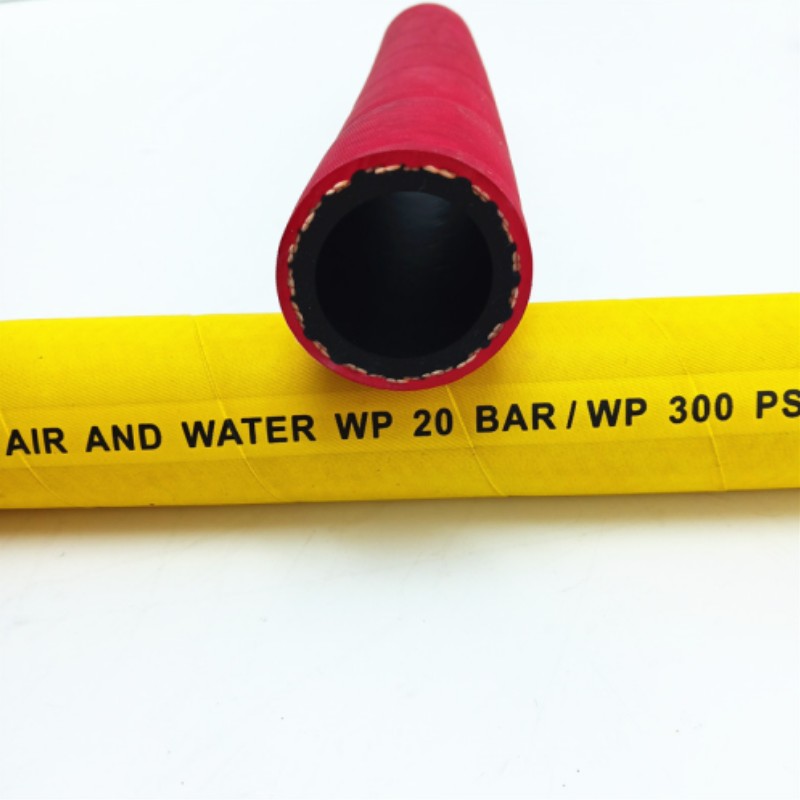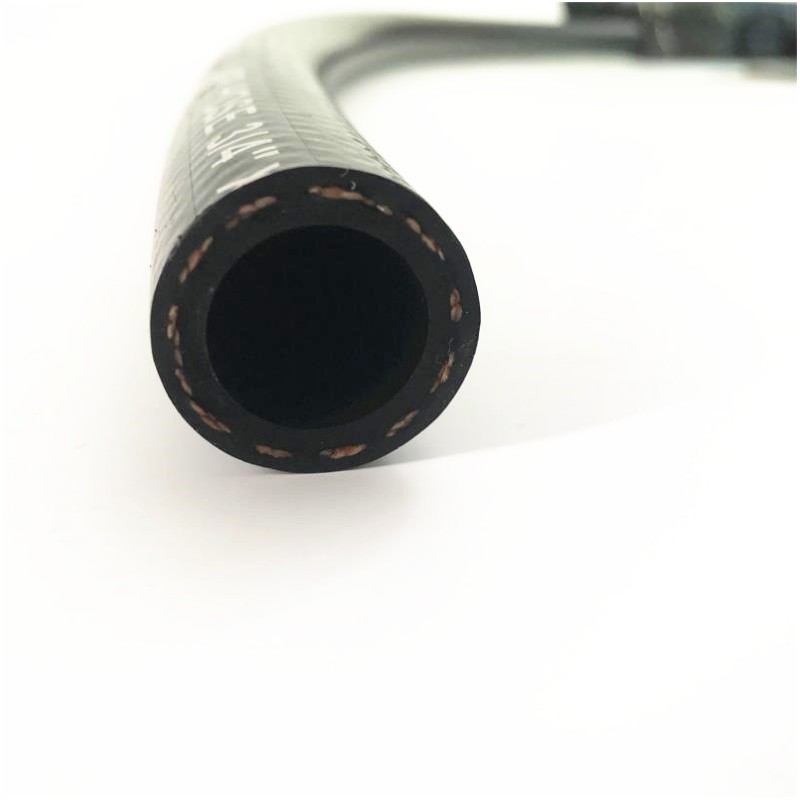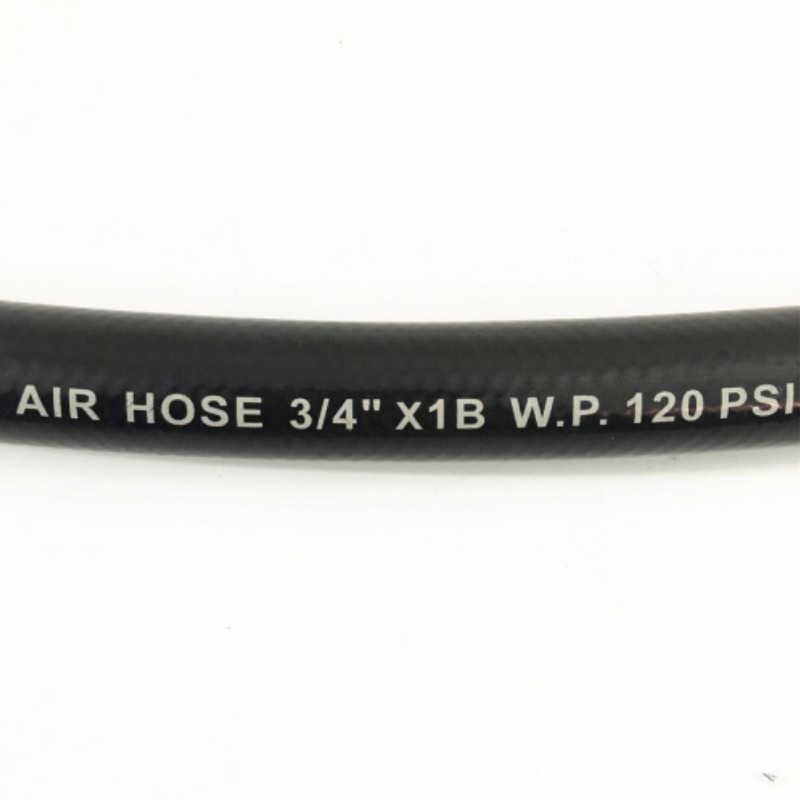LOW PRESSURE AIR & WATER RUBBER HOSE
The rubber air hose 3/8 represents a critical component in industrial pneumatic systems, designed to deliver maximum performance in demanding environments. These hoses feature a specialized construction that provides excellent flexibility, durability, and resistance to environmental factors. At HENGSHUI BAILI HOSE CO.,LTD., we've engineered our air hose solutions to meet the rigorous demands of mining, construction, and industrial applications.
Product Structure & Technical Specifications
Inner Tube: Seamless air and water resistant synthetic rubber for optimal flow efficiency and contamination resistance.
Reinforcement: Single high resistance synthetic fiber braid for strength and kink resistance.
Outer Tube: Black, weather and abrasion resistant synthetic rubber for maximum longevity in harsh conditions.
Temperature Range: -40 to +100°C (-40 to +212°F) ensuring performance in extreme climates.
Safety Factor: 3:1 providing an essential margin for operational safety.
Applications: Heavy works on mining, construction, steel plants, quarries and air compressors.
Surface Options: Available in wrapped and smooth cover for varying environmental requirements.



Industry Trends and Market Developments
The global market for rubber air hose 3/8 products continues to evolve in response to changing industrial requirements. Recent studies indicate a growing demand for more durable, heat resistant rubber hose solutions capable of withstanding higher temperatures in industrial environments (Industrial Hose Market Report 2023).
Significant advancements in rubber compounding technologies have resulted in hoses with enhanced flexibility at low temperatures while maintaining heat resistance properties. This is particularly important for the braided rubber hose segment, where operational flexibility in changing temperatures is crucial.
The development of more sophisticated rubber air brake hose fittings and connection systems has addressed leakage issues that historically accounted for up to 30% of compressed air loss in industrial plants (Compressed Air Best Practices Report 2024). Our Gates rubber hose compatible fittings ensure airtight seals while providing quick installation and disconnection capabilities.
For hydraulic systems that require specialized sizes, our selection includes 3/4 id rubber hose and 1/2 id rubber hose solutions designed to maintain pressure integrity in demanding applications.
Technical Parameters
Understanding specifications is critical when selecting the appropriate rubber air hose 3/8 for your application. Below is a comprehensive comparison of key technical parameters:
| Parameter | Specification | Testing Standard | Comparable Industry Solutions |
|---|---|---|---|
| Inner Diameter | 3/8 inch (9.5mm) | ISO 1307 | 1/4 rubber air hose, 1/2 id rubber hose, 3/4 id rubber hose |
| Working Pressure | 300 PSI (20.7 bar) | ISO 2398 | Exceeds EN853 standard for rubber hose assemblies |
| Burst Pressure | 900 PSI (62.1 bar) | ISO 1402 | 3:1 safety factor exceeds typical 4:1 industry standard |
| Temperature Range | -40°C to +100°C | ISO 7326 | Heat resistant rubber hose performance class A |
| Bend Radius | 125mm (minimum) | ISO 8331 | Superior to standard 3 4 inch rubber hose requirements |
| Weight | 320 g/m ±5% | ISO 3303 | Lighter than equivalent braided rubber hose designs |
| Certifications | CE, MSHA, RoHS | International Standards | Compliance with ISO 5774 for power steering rubber hose |
Application Areas
The versatility of rubber air hose 3/8 solutions makes them indispensable across numerous industries. Each application demands specific hose characteristics:
Construction & Mining
In these abrasive environments, our hoses feature specially formulated rubber compounds providing up to 200% better abrasion resistance than standard solutions. The 3 4 inch rubber hose variations are particularly valued for rock drilling applications where larger airflow volumes are required.
Manufacturing & Assembly
Pneumatic tools require consistent, pulse-resistant air delivery. Our braided rubber hose construction dampens pressure spikes that can damage tools, improving tool lifespan by up to 40% (Factory Equipment Management, 2023).
Transportation Systems
When used as rubber air brake hose fittings, our products meet the stringent requirements of FMVSS-571.106 braking systems with special focus on flexibility at low temperatures and resistance to ozone degradation.
Hydraulic Power Systems
As power steering rubber hose components, our solutions are compatible with both mineral oil-based and synthetic fluid power transmission systems. The 1/4 rubber air hose size is particularly popular in compact mobile applications.
Professional FAQ
Industry References & Citations
- International Organization for Standardization. (2023). ISO 5774: Rubber and plastics hoses for compressed air - Specification.
- Fluid Power Journal. (2024). Technological Advancements in Industrial Hose Design.
- Pneumatic Systems Annual Review. (2023). Pressure Dynamics in Industrial Air Delivery Systems.
- SAE International. (2024). J188 Standard for Hydraulic Hose Fittings.
- Industrial Safety Review. (2024). Safety Factors in High-Pressure Pneumatic Systems.
- European Rubber Journal. (2023). Advances in Synthetic Rubber Compounds for Extreme Environments.
- Compressed Air Best Practices. (2024). Energy Efficiency in Industrial Air Systems.
- Mining Equipment Quarterly. (2023). Hose Selection for Abrasive Mining Environments.
